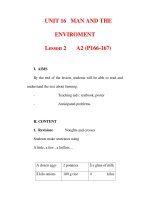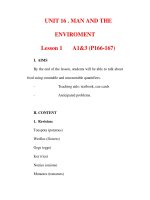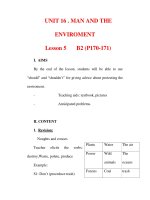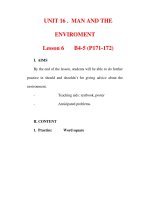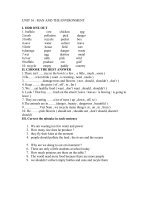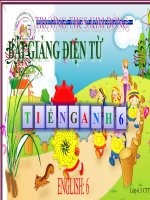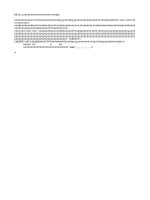- Trang chủ >>
- Đề thi >>
- Đề thi lớp 2
Unit 16 Man and the environment
Bạn đang xem bản rút gọn của tài liệu. Xem và tải ngay bản đầy đủ của tài liệu tại đây (135.05 KB, 14 trang )
<span class='text_page_counter'>(1)</span>Planning :…………………………. UNIT 16 MAN AND THE ENVIRONMENT This unit is divided into 5 periods : + P96 Lesson 1 : A1,3 + P99 Lesson 4: B1 + P97 Lesson 2: A 2 + P 100 Lesson 5 : B2-5 + P98 Lesson 3 : A. Further Practice Date of teaching: ……………………… PART A: ANIMALS AND PLANTS Period 96: Lesson 1 A1,3 A. Aims: - To help ss maste countable and uncountable quantifiers: a lot, a little, a few to talk about Food. B. Objective : -By the end of the lesson, ss will be able to practice countable and uncountable quantifiers: a lot, a little, a few to talk about Food. C. Materials : - A textbook , a board, pictures, tape, …. D. Ways of working : - TWC, WCT, teamwork, group work, pair work & individuals. E. Anticipated Problems: - Some weak ss may get difficulties in Chain game. F. Procedures : I. Warmer: - Greetings: - Revision: Jumble words toespota = potatoes gegs = eggs werflos = lowers /motatoes = tomatoes icer = rice tableveges = vegetable nonios = onions II. New lesson: Teacher’s activities. Students’activities. Contents 1.Presentation: a) Presentation Text : A1 p.166. -Presents the text. -Reads it modally.. -Listen and repeat .. -Gives the model Sents on the board.. -Listen and repeat. -Practice in pairs. b) Model sentences: -How much rice is there ? some.
<span class='text_page_counter'>(2)</span> -Sets the Scene using the target -Concepts checking language.. -There are. -There are. -Uses pictures in the textbook page 167. -Read out the sentence in order. -Corrects -Draws these pictures on the board. -Gives examples -Puts Ss in pairs. -Asks three Ss to do example. Divides class into groups of four. -Monitors and corrects the common mistakes. a lot of(= lots of) a little some a lot of(= lots of) a little. rice. eggs. 2.Practice: a)Matching: A3 p.167 Answer key -Look at the 1. There are lots of vegetables 1.d pictures 2. There are some flowers 2.f -Listen to the 3. There are some tomatoes 3.b teacher 4.There are a lot of potatoes 4.a Number 1,2,3,4... 5. There are a few onions 5.c or the pictures. 6. There is a little rice 6.e -use the pictures to b)Picture Drill: A1 p.166 and A3 p.167 ask their partner. Examples Exchange: S1: How much [rice] is there S2: There ‘ s [a lot /lots]. S1:How many [onions]are there? -Practice in pairs. S2:There are [a few]. 3.Further practice: *Chain Game: -Practice saying ”What ‘s for dinner ?” sentences using the Ex: target language. S1: There’s a little rice -Practice in groups S2: There’s a little rice and some tomatoes S1: There’s a little rice , some tomatoes and a few eggs. S4: etc... 4.Homework: -Make 5 sentences -Do A1 -3 in the work book. Assessment: ………………………………………………………………………………………………………………… ………………………………………………………………………………………………………………….
<span class='text_page_counter'>(3)</span> ………………………………………………………………………………………………………………… ………………………………………………………… Hà Nội, ngày …… tháng ………… năm ……… Ký duyệt của Ban Giám Hiệu: Date of teaching: ……………………… PART A: ANIMALS AND PLANTS Period 97: Lesson 2 A2 A. Aims: - To help ss reading a text about farming and getting further practice in a lot, a little, a few. B. Objective : -By the end of the lesson, ss will be able to understand a text about farming and getting further practice in a lot, a little, a few . C. Materials : - A textbook , a board, pictures, tape, …. D. Ways of working : - TWC, WCT, teamwork, group work, pair work & individuals. E. Anticipated Problems: - Some weak ss may get difficulties in Board drill. F. Procedures : I. Warmer: - Greetings: - Revision: Noughts and Crosses “There [is a little rice]” a dozen eggs 2 potatoes ½ a glass of milk ½ kilo onions 100g rice 4 kilo vegetable 1 kilo fruit 2 tomatoes 2 flowers II. New lesson:. Teacher’s activities. Students’activities. Contents I.Pre reading:. - Elicit the new. -listen and repeat. words through. in chorus. pictures and other. - some read. ways. - tell the meaning. - read twice. - copy down. 1.Pre teach: on the Farm a) animals a buffalo a crow. - write on the board. -mark stress - Checks voc: Matching. 2.Open Prediction Mr. Hai has 1. 3. 5. 2. 4. 6.. b)work ( to ) plow ( to ) pull a cart ( to ) grow ( to ) produce Mrs. Hai Produces 1. 3. 5. 2. 4..
<span class='text_page_counter'>(4)</span> *Set the scene:. -guess. -Ask ss to guess. - read and check. all the qs.. -close pairs then. II.While reading:. *Answer key Mr Hai has Mrs Hai Produces - ask ss to read and - listen and read 1. paddy fields 1. rice check 2. a small field 2. vegetables - ask ss to open 3. fruit trees 3. fruit their book , listen to 4. buffalo 4. milk the tape and read 5. cows 5.eggs the text. 6. chickens *Comprehension Question -reread the text and -reread and find the A2 p167(a e) find the answers for answers for all qs. open pairs. -ask ss to fill in the. -fill in the grids,. grids.. check and correct. *Grids (with answer key) Hai has/ grows / pro. paddy fields rice vegetables fruit trees fruit animals buffalo cows milk chickens eggs. a lot some a few. a little. . . III. Post reading: Board drill -use the grids above for cues for the drill. S1: How many [paddy fields] does Mr Hai [have]?.
<span class='text_page_counter'>(5)</span> S2: [some] S1: How much [rice] does Mr Hai [produce]? S2: [a lot] IV. Homework: - Write a short paragraph about Mr. hai. -redo the Qs -Do A1 - 3 in the work book. Assessment: ………………………………………………………………………………………………………………… ………………………………………………………………………………………………………………… ………………………………………………………………………………………………………………… ………………………………………………………………………………………………………………… ……………………………………………….
<span class='text_page_counter'>(6)</span> Date of teaching: ……………………… PART A: ANIMALS AND PLANTS Period 98: Lesson 3 Further practice A. Aims: - To help ss have further practice in countable and uncountable quantifiers: a lot/ lots of, a little, a few . B. Objective : -By the end of the lesson, ss will be able to use countable and uncountable quantifiers: a lot/ lots of, a little, a few. C. Materials : - A textbook , a board, pictures, tape, …. D. Ways of working : - TWC, WCT, teamwork, group work, pair work & individuals. E. Anticipated Problems: - Some weak ss may get difficulties in doing exercises. F. Procedures : I. Warmer: - Greetings: - Revision: Noughts and Crosses “There [is a little rice]” a dozen eggs 2 potatoes ½ a glass of milk ½ kilo onions 100g rice 4 kilo vegetable 1 kilo fruit 2 tomatoes 2 flowers. II. New lesson: I) Fill a little, little, few, a few in the blank: 1. He doesn’t speak much English. Only ……………………. words. 2. Have you got any money? – Yes, ………………DO you want to borrow some? 3. I enjoy my llife here. I have ………………. friends and we meet quite often. 4. The cinema is almost empty. There are very ……………….. people. 5. Hurry up! WE’ve got ………………… time..
<span class='text_page_counter'>(7)</span> 6. There are only …………………. seats left on the flight. 7. There is ………………… butter in the frigde. Will that do? 8. Would you like some more sugar? Yes, please, just ……………….. 9. There is ………………….. rain in deserts. 10. According to the weather forecast it may be foggy in the next …………. Days. *answers key: 1. a few. 2. A little. 3. A few. 4. Few. 5. Little. 6. a few. 7. A little. 8. A little. 9. Little. 10.few. II. Fill some, any, many, much in the blank: 1. How ………………….languages can you speak? 2. Are there ………………… letters for me this morning? 3. There isn’t …………………. Coffee left. You should go out and buy …………….. 4. How ………………… is an ice cream? 5. Can I have …………………… tea, please? 6. There are ……………… stars in the sky on clear summer nights. 7. –Do the farmers produce ……………….. rice in this season? -Yes, they have a rich harvest. 8. –How …………….. are they all together? - Not very ……………….Only $5. *Answers: 1.many. 2. Any. 3. Any, some. 4. Much. 5. some. 6. Many. 7. Much. 8. Much, much. III. Give the correct form of adjectives: 1.The country is …………………………. the city. (quiet) 2. Park House has got a ………………… garden ………………….. Rose Cottage.(big) 3. Tim has ………………. friends ……………….. Peter. (few) 4. Phanxipang is ………………………… mountain in Vietnam. (high) 5. Lien’s English paper is ………………………… of the group. (bad) 6. Which is ……………….. river in Britain? (long) 7. Jennifer is ………………………of the two sisters. (old) 8. Which color do you like ………………………….? (good) 9. Are the streets of Paris ………………………….. the streets of New York? (clean).
<span class='text_page_counter'>(8)</span> 10. Nam is ………………………. pupil in our class. (funny) *Answers: 1. quieter. 2. Bigger than. 6. the longest. 3. Fewer than. 7. The elder. 8. Best. 4. The highest 9. Cleaner. 5. The worst 10. The funniest.. *Homework: -Redo all exercises Assessment: ………………………………………………………………………………………………………………… ………………………………………………………………………………………………………………… ………………………………………………………………………………………………………………… ………………………………………………………………………………………………………………… ……………………………………………… Date of teaching: ……………………… Unit 16 (cont) PART B: ENVIRONTMENT Period 99: Lesson 4 B1 A. Aims: - To help ss reading a text about Pollution for vocabulary and to understand ideas. B. Objective : -By the end of the lesson, ss will be able to understand a text about Pollution for vocabulary and to understand ideas . C. Materials : - A textbook , a board, pictures, tape, …. D. Ways of working : - TWC, WCT, teamwork, group work, pair work & individuals. E. Anticipated Problems: - Some weak ss may get difficulties in Write it up. F. Procedures : I. Warmer: - Greetings: - Revision: Slap the board II. New lesson:. Teacher’s activities - Elicit the new. Students’activities. Contents. -listen and repeat. I. Pre reading:. words through. in chorus. 1.Pre teach:. pictures and other. - some read. ways. - tell the meaning. -The environment -The ocean= the sea.
<span class='text_page_counter'>(9)</span> - read twice. - copy down. - write on the board. -mark stress - Checks voc:Ro &R *set the scene: -ask ss to guess. -ss guess. -the air -trash -(to) pollute -(to) waste -power: coal oil- gas 2.Pre-question predict 1-What are we destroying? a) b) c) 2-What are we wasting? a) b) 3-What are we polluting? a) c) b) d) II. While reading:. -ask ss to open the book, read and. -open the book, read and check. check. -reread and do comprehention. -ss read and do comprehention. * Read the part B1 on p.169 and check their predictions Answer key: 1-a) forests b) plants c)Wild animals 2-a)water b) power (coal, oil, gas) 3-a) the air b) the land c) the rivers d) the oceans *Comprehension questions :B1 p.170 a) – d) III.Post reading:.
<span class='text_page_counter'>(10)</span> questions.. questions.. -do individuals -ask ss to write by using Pre questions.. *Write it up. Examples: From “what are we destroying?” Don’t destroy the forests. From “what are wasting?” Don’t waste water ->Don’t destroy the wild animals -> Don’t waste power -> Don’t pollute the air / land / rivers/occeans *Homework: - Write a short paragraph about what you do or don’t do for our environment - Do Part B in the workbook. Assessment: ………………………………………………………………………………………………………………… ………………………………………………………………………………………………………………… ………………………………………………………………………………………………………………… ………………………………………………………………………………………………………………… ……………………………………………… Hà Nội, ngày ………. Tháng ………. Năm …………. Ký duyệt của Ban Giám Hiệu:.
<span class='text_page_counter'>(11)</span> Date of teaching: ……………………… Unit 16 (cont) PART B: ENVIRONTMENT Period 100: Lesson 5 B2 -5 A. Aims: - To help ss maste model: Should and Shouldn’t for giving advice about protecting the environment. B. Objective : -By the end of the lesson, ss will be able to use model Should and Shouldn’t for giving advice about protecting the environment. C. Materials : - A textbook , a board, pictures, tape, …. D. Ways of working : - TWC, WCT, teamwork, group work, pair work & individuals. E. Anticipated Problems: - Some weak ss may get difficulties in write it up. F. Procedures : I. Warmer: - Greetings:.
<span class='text_page_counter'>(12)</span> - Revision: II. New lesson:. Teacher’s activities. Students’activities. Contents. I.Presentation: - ask ss to match -match 1.B2 Matching: -check and correct *Answer keys: then read in chorus a) Picture c e) picture e b) Picture f f) Picture b c) Picture a g) Picture g d) Picture h h) Picture d *Guess from context (to) Throw - asks ss to guess -ss guess the (to) Pick the meaning and meaning then repeat in (to) Damage chorus. (to) Keep off (to) Save (to) collect *Model sentence we should collect paper -gives model and do -listen and answer save water concept check T’s qs. -copy down. we shouldn’t throw trash on the street damage trees Should or shouldn’t : give advice 2. B4: Ro & R dialogue: Lan: We shouldn’t leave our trash -repeat in chorus Nga: What are we going to do? -ask ss to read -go the board and fill Lan: Put it in a trash can - go to the board in the missing words. and fill in the Nam: There aren’t any trash cans missing words. Lan: Then we should put it in a bag and take it home. II.Practice:*B5 Picture drill -repeat Water-waste / save -run through all -open pairs then Power-waste / save cues close pairs - model Paper-burn / collect TWC,WCT, half2, s Trash-leave / put in in the trash can –s.
<span class='text_page_counter'>(13)</span> -number: close pairs. Trees-damage / grow Forests-cut down / grow Bottles-throw / collect. Flowers-pick / leave +Example Exchanges S1: we shouldn’t waste water S2: That’s right. We should save it. -work in groups. - ask ss to work in group -. S1: We shouldn’t damage trees S2: That’s right. We should grow them III. Further practice: Write it up *Group 1: Our school *Group 2: Our neighborhood *Group 3: Our country Example Our school should be a beautiful environment. WE should put our trash in the trash cans. We shouldn’t waste water or power when we are at school. We should plant more flowers and trees in the school yard. We shouldn’t damage them when we play football. We should collect paper, bottles and cans and take them home. *Homework: -make 10 sentences - DO all exercises in part B in the workbook.. Assessment: ………………………………………………………………………………………………………………… ………………………………………………………………………………………………………………… ………………………………………………………………………………………………………………… ………………………………………………………………………………………………………………… ……………………………………………….
<span class='text_page_counter'>(14)</span>
<span class='text_page_counter'>(15)</span>


